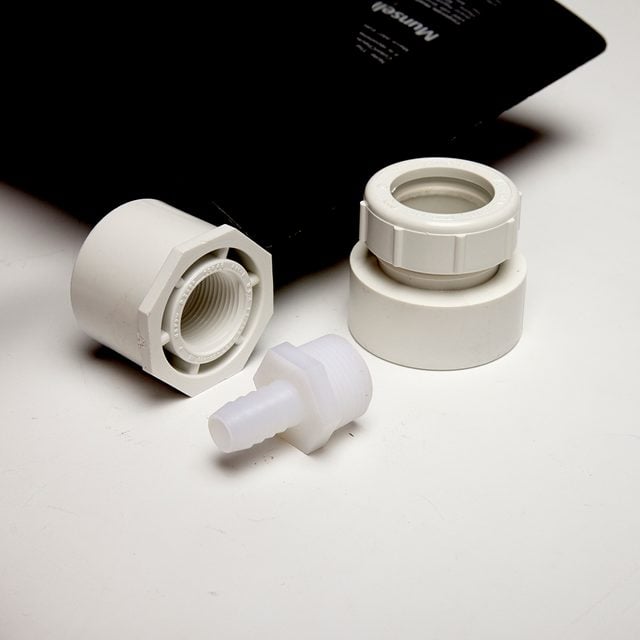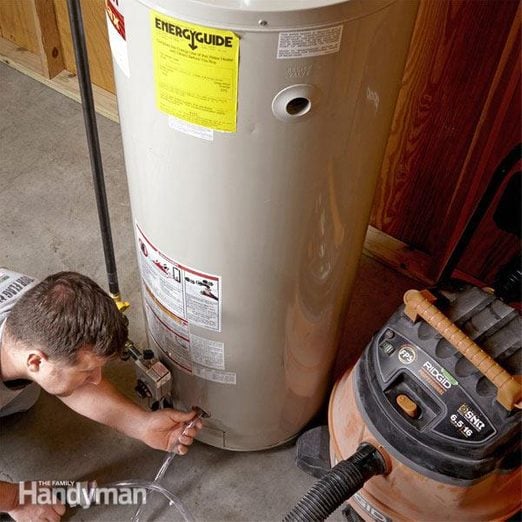How to Flush a Hot Water Heater
Updated: Mar. 22, 2023
Extend the life of your water heater: Learn how to drain water heater fluid and get your water heater running like new.
A few hours
Intermediate
$51–100
Introduction
Have you flushed your water heater lately? This important chore should be done at least once a year to remove sediment that accumulates on the bottom of the tank. That's especially true if you live in a hard-water area. The task is easy to ignore because it's out of sight—but built-up sediment reduces the heating efficiency of your water heater and costs you money.Tools Required
- 4-in-1 screwdriver
- Adjustable wrench
- Bucket
- Hacksaw
- Hammer
- Knee pads
- Plumbers tape
- Rags
- Shop vacuum
- Slip joint pliers
Materials Required
- 1-1/4-in. x 1-1/2-in. female PVC trap adapter
- 2" brass nipple
- 24-in. piece of 1/2-in. I.D. vinyl tubing
- 3/4-in. MIP x 1/2-in. barb fitting
- 3/4-in. x 3-in. nipple
- Brass ball valve
- Brass elbow
- Dielectric nipple
- Garden hose adapter
- Shop vacuum hose adapter
If you’ve never flushed your hot water heater, or haven’t done it in years, you could be in for a nasty surprise—in the form of sediment build-up. One sign of excessive sediment buildup is a popping or rumbling sound coming from your water heater. That’s the sound of steam bubbles percolating up through the muck. On a gas water heater, the sediment creates hot spots that can damage the tank and cause premature failure. On an electric water heater, sediment buildup can cause the lower heating element to fail. So learning how to drain a water heater and flushing offers a payback in lower energy bills and will extend the life of your hot water heater.
This is what the sediment in your water heater looks like. 
Project step-by-step (8)
Build a Shop Vacuum Adapter
- Glue a 1-1/2-inch PVC x 3/4-inch FIP adapter (A) onto a female PVC trap adapter (B).
- Note: This allows you to attach your shop vacuum to 3/4-inch pipe. The barbed fitting (C) connects to 1/2-inch I.D. vinyl tubing.

Drain Water Heater Liquid
- Shut off the gas or flip the circuit breaker to shut off the electricity to the water heater.
- Open a hot water faucet somewhere else in the house and let it run full blast for about 10 minutes to reduce the water temperature in the tank.
- Shut off the cold water valve at the top of the tank and attach a garden hose to the existing drain valve and route it to a floor drain.
- Pro tip: Use a kitchen colander to catch the sediment so it doesn’t clog the floor drain.
- Open a hot water faucet closest to the water heater, preferably on an upper floor, and the water heater drain valve.
- Let the tank drain until sediment clogs the valve and reduces the flow.
- Close the hot water faucet and water heater drain valve.
- Remove the temperature-pressure release valve and screw in the vacuum adapter.
- Attach the shop vacuum hose and fire up the vacuum.
- Note: This applies suction to the tank so you won’t get soaked when you yank the old drain valve.

Remove the Old Valve
- While applying suction through the TPR port with a shop vacuum, unscrew and remove the valve by turning the plastic nut behind the knob.
- Pro tip: If it breaks off, saw the broken portion with a hacksaw blade until you hit metal threads. Then use a hammer and screwdriver to chip out the pieces.

Assemble the New Valve
- Remove the handle from the ball valve so you can assemble all the 3/4-inch fittings.
- Build a new drain valve with a 3/4-inch full-port brass ball valve with threaded ends, a 3-inch x 3/4-inch galvanized nipple and a 3/4-inch MIP x G.H. garden hose adapter (one choice is the BrassCraft/Plumbshop No. HU22-12-12TP).
- Note: As soon as you open the drain valve, the sediment will likely clog it and prevent you from closing the valve all the way after it’s drained. Then you’ll have sediment buildup and a leaking water heater. Not only will an old drain clog up, but you won’t be able to suck debris through its small opening. This is why you need to build a new drain valve.
Install the New Valve
- Install the new full-port valve in closed position.
- Attach one end of the garden hose to the valve and run the other end into a colander set over the floor drain.

CAUTION!
Remove the ball valve handle after you flush the water heater, especially if the water heater is located where people could walk by it and accidentally bump the handle. The valve could open and release scalding water, causing serious burns. (Twist-tie the handle to the valve so you don’t lose it.)
Flush the Tank
- Remove the vacuum hose from the TPR port and flush the tank.
- Pro tip: Most of the sediment will flush out through the full-port valve. To remove the rest, open the cold water valve at the top of the tank in short bursts to blast it toward the drain.
- Let the water flow until it runs clear.

Suck Out the Sediment
- Remove the full-port valve and suck out the remaining sediment with your shop vacuum adapter and 1/2-inch vinyl tubing.
- When you’re done, close the ball valve and leave it in place, but remove the lever handle to prevent accidental opening.
- Then reinstall the TPR valve and blow-off tube.

Refill the Water Heater
- Refill the water heater.
- Turn on the gas or electricity.
